Cockroach Control for Better Hygiene: The Unwanted Guests That Refuse to Leave
Imagine a creature so resilient that it can survive without its head for days, a pest so stubborn that even the strongest pesticides struggle to take it down. Cockroaches are the ultimate survivalists, nature’s tiny tanks, designed to endure conditions that would break most living beings. They scurry through the cracks of our homes, creeping out under the cover of night, seeking food, water, and shelter. If left unchecked, they multiply at an alarming rate, turning a minor nuisance into a full-blown infestation.

The Cockroach Army: A Brief Introduction
Cockroaches are not a singular enemy; they come in an army of over 4,000 species, divided into six families. While most of these species prefer to dwell far from human settlements, a select few have made our kitchens, bathrooms, and basements their battlefield. Among these, the most notorious offenders are the American and German cockroaches. These two species are responsible for the majority of household infestations and have developed a near-mythical resistance to traditional control methods.
The American Cockroach: The Grand Invader
The American cockroach (Periplaneta americana) is the behemoth of the cockroach world. Measuring up to two inches in length, this reddish-brown insect moves with an unsettling speed, darting away the moment the lights flicker on. Preferring warm, damp environments, it thrives in sewers, basements, and even beneath kitchen sinks. Though it is large, its real terror lies in its ability to spread bacteria, contaminating food and surfaces with each scuttle.

The German Cockroach: The True Mastermind
If the American cockroach is the brute force, the German cockroach (Blattella germanica) is the mastermind. This tiny, light-brown insect is one of the most difficult household pests to eradicate. Not only does it reproduce at an astonishing rate, but it also has an uncanny ability to develop resistance to pesticides. Traditional methods often fall short, making finding the best German roach killer an absolute necessity for homeowners struggling with infestations.
The Battle Plan: How to Keep Roaches at Bay
The key to winning the war against cockroaches lies in understanding their behavior and using a multi-faceted approach:
- Eliminate Food Sources – Roaches are relentless scavengers. Ensure all food is stored in airtight containers, wipe down surfaces regularly, and avoid leaving dirty dishes overnight.
- Cut Off Water Supply – Like all living creatures, roaches need water to survive. Fix leaky faucets, dry sinks before bed, and keep bathrooms well-ventilated.
- Seal Entry Points – Roaches are masters of infiltration. Caulk cracks in walls, seal gaps around pipes, and install door sweeps to keep them out.
- Use Baits and Traps – For a targeted attack, baits are one of the most effective solutions. The best German roach killer baits contain slow-acting poisons that roaches carry back to their nests, wiping out entire colonies.
- Employ Insect Growth Regulators (IGRs) – These chemicals disrupt the reproductive cycle of roaches, preventing nymphs from maturing into breeding adults.
- Call the Professionals – In severe cases, professional exterminators have access to industrial-strength treatments that can eliminate even the most resistant cockroach populations.
The Final Stand Against the Invaders
Cockroach control isn’t just about comfort—it’s about hygiene, health, and peace of mind. These resilient pests can spread disease, trigger allergies, and create an unsanitary living environment. While their adaptability makes them formidable opponents, knowledge and persistence will always tip the scales in our favor. By understanding their habits and using the best German roach killer, combined with preventive measures, you can reclaim your home and keep these unwelcome guests at bay. The battle may be tough, but with the right strategy, victory is within reach.






